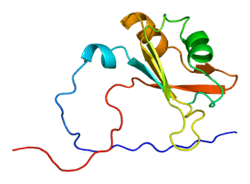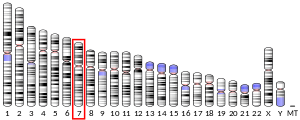HNRNPA2B1
Heterogeneous nuclear ribonucleoproteins A2/B1 is a protein that in humans is encoded by the HNRNPA2B1 gene.[5]
Structure
HNRNPA2B1 gene contains 12 exons, including a B1 protein specific 36-nucleotide mini-exon. The entire length of intron/exon organization of HNRNPA2B1 is identical to that of the HNRNPA1 gene which indicates a common origin by gene duplication.[6]
Function
This gene belongs to the A/B subfamily of ubiquitously expressed heterogeneous nuclear ribonucleoproteins (hnRNPs). The hnRNPs are RNA binding proteins and they complex with heterogeneous nuclear RNA (hnRNA). These proteins are associated with pre-mRNAs in the nucleus and appear to influence pre-mRNA processing and other aspects of mRNA metabolism and transport. While all of the hnRNPs are present in the nucleus, some seem to shuttle between the nucleus and the cytoplasm. The hnRNP proteins have distinct nucleic acid binding properties. The protein encoded by this gene has two repeats of quasi-RRM domains that bind to RNAs. This gene has been described to generate two alternatively spliced transcript variants which encode different isoforms.[7] HnRNPA2B1 is an autoantigen in autoimmune diseases such as rheumatoid arthritis, systemic lupus erythematosus and mixed connective tissue disease. When referred to as an autoantigen, hnRNPA2B1 is also known as RA33.
The HNRNPA2 and HNRNPB1 proteins are involved in packaging nascent mRNA, in alternative splicing, and in cytoplasmic RNA trafficking, translation, and stabilization. HNRNPA2 and HNRNPB1 also appear to function in telomere maintenance, cell proliferation and differentiation, and glucose transport.[8][9]
Function of HNRNPA2B1 gene can be effectively examined by siRNA knockdown based on an independent validation.[10]
Interactions
HNRPA2B1 has been shown to interact with casein kinase 2, alpha 1.[11]
Role in diseases
The mutation p.D290V/302V in hnRNPA2B1 is implicated in dementia, myopathy, PDB, and ALS.[12] Mutations in hnRNPA2B1 and hnRNPA1 cause of amyotrophic lateral sclerosis and multisystem proteinopathy.[13] hnRNPA2/B1 is found to activate cyclooxygenase-2 and promote tumor growth in human lung cancers.[14]
References
- GRCh38: Ensembl release 89: ENSG00000122566 - Ensembl, May 2017
- GRCm38: Ensembl release 89: ENSMUSG00000004980 - Ensembl, May 2017
- "Human PubMed Reference:". National Center for Biotechnology Information, U.S. National Library of Medicine.
- "Mouse PubMed Reference:". National Center for Biotechnology Information, U.S. National Library of Medicine.
- Biamonti G, Ruggiu M, Saccone S, Della Valle G, Riva S (August 1994). "Two homologous genes, originated by duplication, encode the human hnRNP proteins A2 and A1". Nucleic Acids Res. 22 (11): 1996–2002. doi:10.1093/nar/22.11.1996. PMC 308112. PMID 8029005.
- "Error 403".
- "Entrez Gene: HNRPA2B1 heterogeneous nuclear ribonucleoprotein A2/B1".
- "HNRNPA2B1 heterogeneous nuclear ribonucleoprotein A2/B1 [Homo sapiens (human)] - Gene - NCBI".
- "Error 403".
- Munkácsy, Gyöngyi; Sztupinszki, Zsófia; Herman, Péter; Bán, Bence; Pénzváltó, Zsófia; Szarvas, Nóra; Győrffy, Balázs (1 January 2016). "Validation of RNAi Silencing Efficiency Using Gene Array Data shows 18.5% Failure Rate across 429 Independent Experiments". Molecular Therapy - Nucleic Acids. 5 (9): e366. doi:10.1038/mtna.2016.66. ISSN 2162-2531. PMC 5056990. PMID 27673562.
- Pancetti F, Bosser R, Krehan A, Pyerin W, Itarte E, Bachs O (June 1999). "Heterogeneous nuclear ribonucleoprotein A2 interacts with protein kinase CK2". Biochem. Biophys. Res. Commun. 260 (1): 17–22. doi:10.1006/bbrc.1999.0849. PMID 10381337.
- Kim HJ, Kim NC, Wang YD, Scarborough EA, Moore J, Diaz Z, MacLea KS, Freibaum B, Li S, Molliex A, Kanagaraj AP, Carter R, Boylan KB, Wojtas AM, Rademakers R, Pinkus JL, Greenberg SA, Trojanowski JQ, Traynor BJ, Smith BN, Topp S, Gkazi AS, Miller J, Shaw CE, Kottlors M, Kirschner J, Pestronk A, Li YR, Ford AF, Gitler AD, Benatar M, King OD, Kimonis VE, Ross ED, Weihl CC, Shorter J, Taylor JP (2013). "Mutations in prion-like domains in hnRNPA2B1 and hnRNPA1 cause multisystem proteinopathy and ALS". Nature. 495 (7442): 467–73. doi:10.1038/nature11922. PMC 3756911. PMID 23455423.
- Kim HJ, Kim NC, Wang YD, Scarborough EA, Moore J, Diaz Z, et al.Mutations in prion-like domains in hnRNPA2B1 and hnRNPA1 causemultisystem proteinopathy and ALS. Nature 2013;495:467–73. Available from: https://www.researchgate.net/publication/235770144_Mutations_in_prion-like_domains_in_hnRNPA2B1_and_hnRNPA1_cause_multisystem_proteinopathy_and_ALS [accessed Mar 28, 2017].
- Xuan Yang, Wang Jingshu, Ban Liying, Lu Jian-Jun, Yi Canhui, Li Zhenglin, Yu Wendan, Li Mei, Xu Tingting, Yang Wenjing, Tang Zhipeng, Tang Ranran, Xiao Xiangsheng, Meng Songshu, Chen Yiming, Liu Quentin, Huang Wenlin, Guo Wei, Cui Xiaonan, Deng Wuguo, (2016), hnRNPA2/B1 activates cyclooxygenase-2 and promotes tumor growth in human lung cancers, Molecular Oncology, 10, doi: 10.1016/j.molonc.2015.11.010. Available from: http://onlinelibrary.wiley.com/doi/10.1016/j.molonc.2015.11.010/abstract;jsessionid=F7FAA0EE2ECB0751450320F2792BFD9E.f03t01
Further reading
- Dawson SJ, White LA (1992). "Treatment of Haemophilus aphrophilus endocarditis with ciprofloxacin". J. Infect. 24 (3): 317–20. doi:10.1016/S0163-4453(05)80037-4. PMID 1602151.
- Bauw G, Rasmussen HH, van den Bulcke M, van Damme J, Puype M, Gesser B, Celis JE, Vandekerckhove J (1990). "Two-dimensional gel electrophoresis, protein electroblotting and microsequencing: a direct link between proteins and genes". Electrophoresis. 11 (7): 528–36. doi:10.1002/elps.1150110703. PMID 1699755.
- Wilk HE, Schaefer KP, Agris PF, Boak AM, Kovacs SA (1991). "U1 SnRNP association with HnRNP involves an initial non-specific splice-site independent interaction of U1 SnRNP protein with HnRNA". Mol. Cell. Biochem. 106 (1): 55–66. doi:10.1007/BF00231189. PMID 1833625.
- Burd CG, Swanson MS, Görlach M, Dreyfuss G (1989). "Primary structures of the heterogeneous nuclear ribonucleoprotein A2, B1, and C2 proteins: a diversity of RNA binding proteins is generated by small peptide inserts". Proc. Natl. Acad. Sci. U.S.A. 86 (24): 9788–92. doi:10.1073/pnas.86.24.9788. PMC 298587. PMID 2557628.
- Kumar A, Williams KR, Szer W (1986). "Purification and domain structure of core hnRNP proteins A1 and A2 and their relationship to single-stranded DNA-binding proteins". J. Biol. Chem. 261 (24): 11266–73. PMID 3733753.
- Faura M, Renau-Piqueras J, Bachs O, Bosser R (1995). "Differential distribution of heterogeneous nuclear ribonucleoproteins in rat tissues". Biochem. Biophys. Res. Commun. 217 (2): 554–60. doi:10.1006/bbrc.1995.2811. PMID 7503735.
- Kozu T, Henrich B, Schäfer KP (1995). "Structure and expression of the gene (HNRPA2B1) encoding the human hnRNP protein A2/B1". Genomics. 25 (2): 365–71. doi:10.1016/0888-7543(95)80035-K. PMID 7789969.
- Van Laer L, Van Camp G, Green ED, Huizing EH, Willems PJ (1997). "Physical mapping of the HOXA1 gene and the hnRPA2B1 gene in a YAC contig from human chromosome 7p14-p15". Hum. Genet. 99 (6): 831–3. doi:10.1007/s004390050457. PMID 9187682.
- Neubauer G, King A, Rappsilber J, Calvio C, Watson M, Ajuh P, Sleeman J, Lamond A, Mann M (1998). "Mass spectrometry and EST-database searching allows characterization of the multi-protein spliceosome complex". Nat. Genet. 20 (1): 46–50. doi:10.1038/1700. PMID 9731529.
- Montuenga LM, Zhou J, Avis I, Vos M, Martinez A, Cuttitta F, Treston AM, Sunday M, Mulshine JL (1998). "Expression of heterogeneous nuclear ribonucleoprotein A2/B1 changes with critical stages of mammalian lung development". Am. J. Respir. Cell Mol. Biol. 19 (4): 554–62. doi:10.1165/ajrcmb.19.4.3185. hdl:10171/20162. PMID 9761751.
- Pancetti F, Bosser R, Krehan A, Pyerin W, Itarte E, Bachs O (1999). "Heterogeneous nuclear ribonucleoprotein A2 interacts with protein kinase CK2". Biochem. Biophys. Res. Commun. 260 (1): 17–22. doi:10.1006/bbrc.1999.0849. PMID 10381337.
- Hamilton BJ, Nichols RC, Tsukamoto H, Boado RJ, Pardridge WM, Rigby WF (1999). "hnRNP A2 and hnRNP L bind the 3'UTR of glucose transporter 1 mRNA and exist as a complex in vivo". Biochem. Biophys. Res. Commun. 261 (3): 646–51. doi:10.1006/bbrc.1999.1040. PMID 10441480.
- Nichols RC, Wang XW, Tang J, Hamilton BJ, High FA, Herschman HR, Rigby WF (2000). "The RGG domain in hnRNP A2 affects subcellular localization". Exp. Cell Res. 256 (2): 522–32. doi:10.1006/excr.2000.4827. PMID 10772824.
- Matsui M, Horiguchi H, Kamma H, Fujiwara M, Ohtsubo R, Ogata T (2000). "Testis- and developmental stage-specific expression of hnRNP A2/B1 splicing isoforms, B0a/b". Biochim. Biophys. Acta. 1493 (1–2): 33–40. doi:10.1016/s0167-4781(00)00154-8. PMID 10978504.
- Zhou J, Allred DC, Avis I, Martínez A, Vos MD, Smith L, Treston AM, Mulshine JL (2001). "Differential expression of the early lung cancer detection marker, heterogeneous nuclear ribonucleoprotein-A2/B1 (hnRNP-A2/B1) in normal breast and neoplastic breast cancer". Breast Cancer Res. Treat. 66 (3): 217–24. doi:10.1023/A:1010631915831. PMID 11510693.
- Pioli PA, Rigby WF (2001). "The von Hippel-Lindau protein interacts with heteronuclear ribonucleoprotein a2 and regulates its expression". J. Biol. Chem. 276 (43): 40346–52. doi:10.1074/jbc.M105391200. PMID 11517223.
- Kim SH, Dierssen M, Ferreres JC, Fountoulakis M, Lubec G (2001). Increased protein levels of heterogeneous nuclear ribonucleoprotein A2/B1 in fetal Down syndrome brains. J. Neural Transm. Suppl. pp. 273–80. doi:10.1007/978-3-7091-6262-0_22. ISBN 978-3-211-83704-7. PMID 11771750.
- Andersen JS, Lyon CE, Fox AH, Leung AK, Lam YW, Steen H, Mann M, Lamond AI (2002). "Directed proteomic analysis of the human nucleolus". Curr. Biol. 12 (1): 1–11. doi:10.1016/S0960-9822(01)00650-9. PMID 11790298.
- Jurica MS, Licklider LJ, Gygi SR, Grigorieff N, Moore MJ (2002). "Purification and characterization of native spliceosomes suitable for three-dimensional structural analysis". RNA. 8 (4): 426–39. doi:10.1017/S1355838202021088. PMC 1370266. PMID 11991638.
- Li S, Zhang P, Freibaum BD, et al. (2016). "Genetic interaction of hnRNPA2B1 and DNAJB6 in a Drosophila model of multisystem proteinopathy". Human Molecular Genetics. 25 (5): 936–950. doi:10.1093/hmg/ddv627. PMC 4754048. PMID 26744327.
- Herman S, Fischer A, Presumey J, Hoffmann M, Koenders MI, Escriou V, Apparailly F, Steiner G (2015). "Inhibition of Inflammation and Bone Erosion by RNA Interference–Mediated Silencing of Heterogeneous Nuclear RNP A2/B1 in Two Experimental Models of Rheumatoid Arthritis". Arthritis & Rheumatology. 67 (9): 2536–2546. doi:10.1002/art.39223. PMID 26017221.
- Kentaro I, Shinji K, Shoko U, Akihito M, Nozomi O, Tatsuki S, Senko T, Tomoe K, Yoichi T, Kengo M, Takao Y, Shingo D, Isamu S, Fumio S (2015). "Ridaifen G, tamoxifen analog, is a potent anticancer drug working through a combinatorial association with multiple cellular factors". Bioorganic & Medicinal Chemistry. 23 (18): 6118–6124. doi:10.1016/j.bmc.2015.08.001. PMID 26314924.
- Geissler R, Simkin A, Floss D, Patel R, Fogarty EA, Scheller J, Grimson A (2016). "A widespread sequence-specific mRNA decay pathway mediated by hnRNPs A1 and A2/B1". Genes & Development. 30 (9): 1070–1085. doi:10.1101/gad.277392.116. PMC 4863738. PMID 27151978.
- QU XH, LIU JL, ZHONG XW, LI X, ZHANG QG (2015). "Insights into the roles of hnRNP A2/B1 and AXL in non-small cell lung cancer". Oncology Letters. 10 (3): 1677–1685. doi:10.3892/ol.2015.3457. PMC 4533760. PMID 26622731.
- Alarcón CR, Goodarzi H, Lee H, Liu X, Tavazoie S, Tavazoie SF (2015). "HNRNPA2B1 is a mediator of m6A-dependent nuclear RNA processing events". Cell. 162 (6): 1299–1308. doi:10.1016/j.cell.2015.08.011. PMC 4673968. PMID 26321680.






